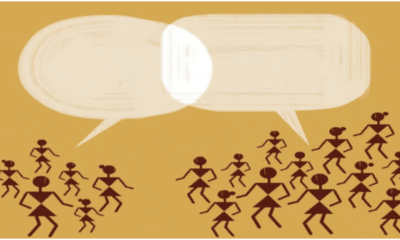
|
Getting your Trinity Audio player ready...
|
(The article was originally published by Indian Express on July 15, 2023 as a part of Dr Madhav’s column titled ‘Ram Rajya’. Views expressed are personal.)
THE EUROPEAN PARLIAMENT’S intervention in what is India’s internal matter, the violence in Manipur, is bound toruffle many feathers in the country. In a session at Strasbourg in France this week, it took up six motions on the violence in the northeastern state and passed a resolution that seems like a propaganda piece.
Discussions on the resolution did not last for even 15 minutes. Some right-wing members of the European Parliament (MEPs) resorted to run-of-the-mill allegations about “persecution” of Christians and other minorities, and Hindu majoritarianism. However, MEPs like Reinhard Butikofer of Germany’s Green Alliance insisted that the resolution “should not be used as an opportunity to insult India or to voice threats against the trade negotiations”.
In her winding up comments, Mairead McGuinness, European Commissioner for Financial Stability, Financial Services and Capital Markets, sounded conciliatory. She said, “Indian authorities have taken a number of measures to address this very tense situation. A commission of Enquiry has been set up and a peace committee has been established with broad participation to facilitate peace negotiations”. Calling India a strategic partner of the EU, she insisted that “mutual respect, protection and promotion of human rights and fundamental freedoms are at the core of the partnership”. McGuinness suggested that the annual India- EU Human Rights Dialogue, scheduled for December, should be a goodop-portunity for free and frank discussion.
However, the final text of the resolution contained comments and innuendoes that are far removed from reality. While some may gleefully quote the resolution as a reproach of the Narendra Modi government, the European Parliament will be decried by many others and asked to focus on the tragic state of affairs in some EU nations – France and Sweden, for instance – instead of poking its nose in the affairs of sovereign nations in other parts of the world.
The European Parliament enjoys some powers over member countries. But it can, at most, be treated as a multilateral body. MEPs moving resolutions that go beyond the EU’s immediate mandate is not uncommon. There is no use picking quarrels with the EU now as the resolution has been passed. Instead, propaganda must be responded to with facts.
Manipur is limping back to normalcy. Representatives of Meiteis and Kukis are in Delhi, holding consultations with the authorities concerned to find an amicable pathway to peace. But the deep wounds caused by the ethnic clashes will take time to heal. Uncalled for interventions and discourses, within the country and outside it – including the European Parliament – can delay the healing process.
“Demography is destiny,” said French thinker Auguste Comte. Manipur’s demography and geography is unique. The Imphal Valley is 10 per cent of the state. But 60 per cent of Manipur’s population lives in the Valley, putting enormous pressure on land.
The state has a diverse demographic profile. Around three million Meiteis constitute 53 per cent of the state’s population, the share of the Nagas is 23 per cent and that of the Kukis is around 16 per cent. Around 8 per cent of Manipur’s population is Muslim.
Meiteis are predominantly Hindu, though there is a growing Christian population among them — different estimates reckon that they could be between 5 and 20 per cent. Nagas and Kukis are almost entirely Christian. The majority of the Meiteis live in the Imphal Valley. The hills surrounding the Valley are occupied by the Kukis and beyond them live the Nagas.
The state’s peculiar geography and demography forced all communities to live in togetherness for centuries. Intermarriage among communities is a common feature. Manipur has had a dozen chief ministers in the last six decades that included Meiteis, Nagas and even Muslims.
While this complex grass roots reality led to a forced rapprochement of sorts between communities, conflict was also a permanent feature in the state, especially in the past few decades. This conflict has nothing to do with religion or any other identity. It’s largely about survival-related issues of people. Land is the principal reason behind the tensions. Although hills constitute 90 per cent of the state’s territory, almost 78 per cent of it is declared as forest land. Thus effectively, the population in both the Valley and hills have access to an equal amount of land resources.
The scarcity of land and instincts of survival are behind the latent feelings of acrimony and misgivings about each other’s intentions. These have given rise to insecurities. Endless negative media and social media propaganda — real and fake — has aggravated xenophobic tendencies on all sides.
Manipur witnessed terrible riots between Nagas and Kukis — both Christian — in 1992-93 that resulted in more than 200 deaths and the ghettoisation of both communities. Strife continued in the early 2000s, forcing people to be relocated to areas where their respective communities were in the majority. Equally bad were the Meitei–Muslim riots that rocked the state towards the end of the 1990s.
The recent Meitei–Kuki violence is also an extension of such conflict. The European Parliament and some church organisations tried to project it as anti-Christian violence. But one of the first places of worship to be attacked was a Hindu temple. Many churches too were attacked. But more than religion, ethnic identity played a major role in this violence. Reports surfaced of Kukis destroying churches in Churachandpur because they belonged to Meitei Christians.
Narrative building precedes creating conditions for peace. When false narratives dominate the discourse in India, as well as outside, peace and reconciliation become difficult.
Manipur is a land of great patriots. Meiteis, Kukis and Nagas have produced countless people who have served the country in various capacities not only in politics but also in the armed forces and foreign, administrative and police services. A visit to the INA Museum at Moirang in Manipur reveals that two-thirds of the soldiers of the INA who sacrificed their lives fighting the British Army were Kukis.
The need of the hour is to build trust among communities. Kukis are a major transnational tribe in the Northeast with a presence in Myanmar and Bangladesh. Hence, fears of illegal migration are not completely unfounded. But to view the entire community from that prism is uncalled for. Similarly, to pin the blame on any one community for the narco trade is wrong because this activity affects people from different communities equally.
Despite conflicts, the people of Manipur have lived together for centuries. They are destined to do so in the future as well.





Excellent Article ! I am a regular reader of the visionery writer and his spectacular contents.
Amezing !